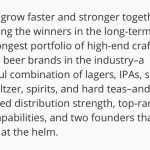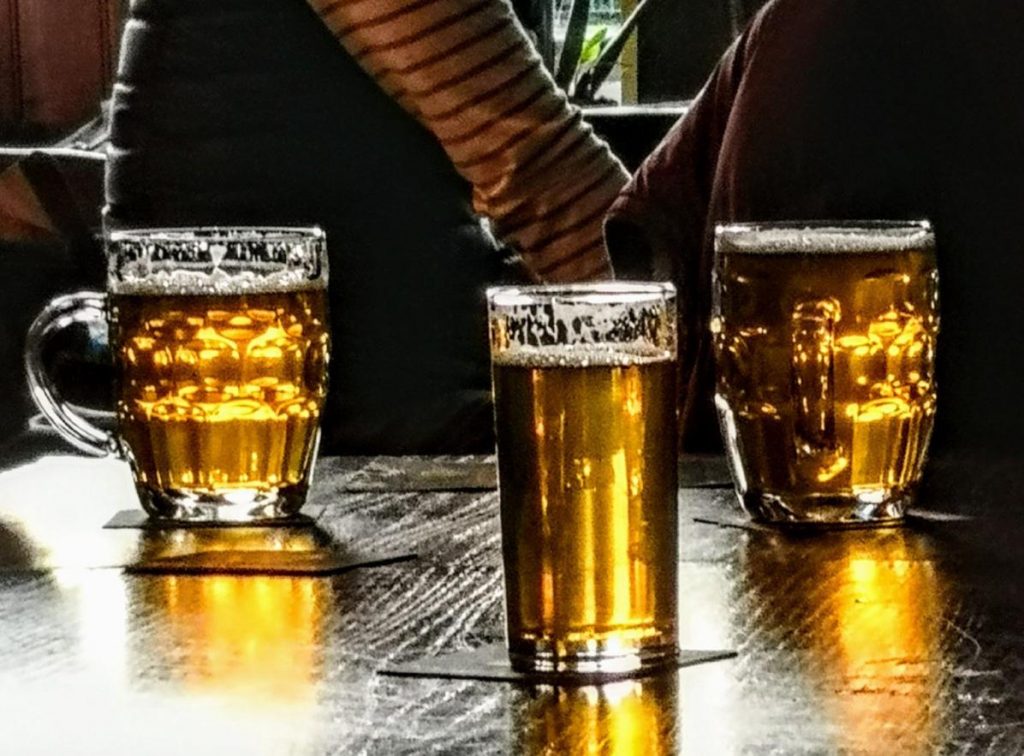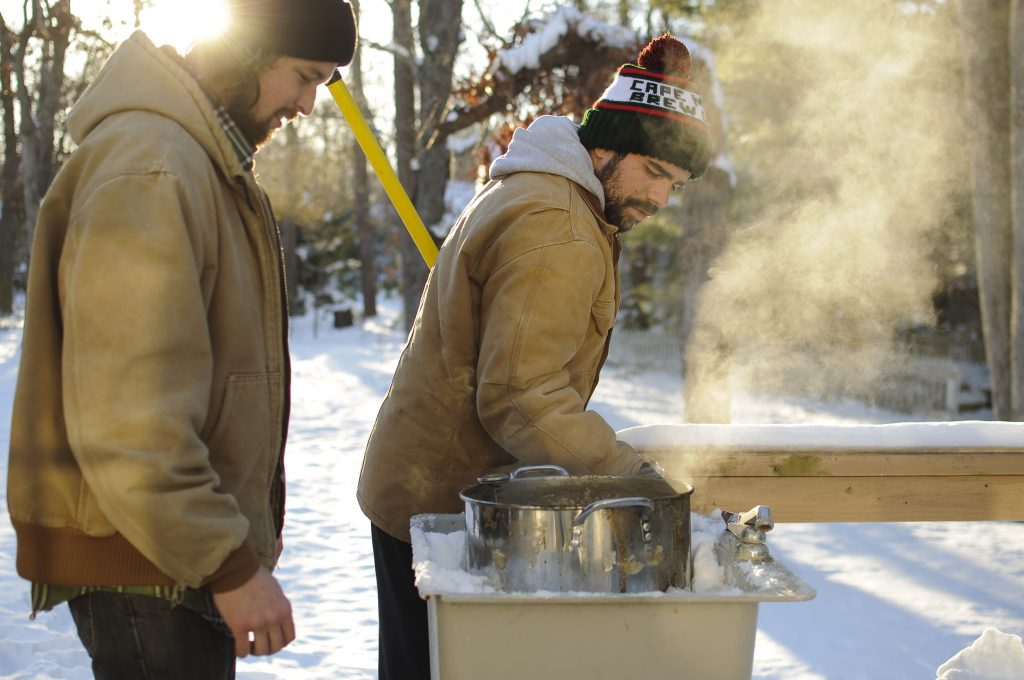Finally. August . I am not one to complain but July has seen me up at 5:45 am most days to drop three householders off at their various destinations about town before I get to my office. There. I complained. And the heat. My genetic code has spent most of its existence in the land of the midnight sun. I burn in the shade. I miss cardigans. There. I complained again.
. I am not one to complain but July has seen me up at 5:45 am most days to drop three householders off at their various destinations about town before I get to my office. There. I complained. And the heat. My genetic code has spent most of its existence in the land of the midnight sun. I burn in the shade. I miss cardigans. There. I complained again.
This week’s photo of the week is from a tweet by @davidtinney1. Ghost signs are always good but this one of Whitbread is lovely.
First news: Stan sent out Vol. 3, No. 3 of his Hop Queries newsletter this week and some of the news from Europe makes other bad news from Europe look like not so bad news from Europe:
The 57th Congress of the International Hop Growers’ Convention is meeting this week in Slovenia. You can bet the weather is being discussed. The heat wave tracked here in Vol. 3, No. 2 was not necessarily a setback for much of this year’s German crop, but another heat wave and lack of precipitation combine to raise new concerns. The situation appears worse in the Czech Republic. A report from July 6: “After climatically promising May the weather in June 2019 unfortunately got back into the groove of previous several years, i.e. to the dry and hot weather. A particularly adverse situation developed at the temperatures, when monthly average reached the value of 21.4°C, exceeding the long-term average of 17°C by 4.4°C. Together with unevenly distributed rains, which were mostly of stormy nature, they had a very negative impact to the growth and development of hops, which seemed to be quite promising in this year.” Harvest begins in a few weeks.
Were I Snagglepuss and this was a 1960s Saturday morning TV cartoon, I might say “Heavens to Murgatroyd!” but I am not so I won’t.
Next up, the Tand Himself shared his thoughts on the state and source of murk as we know it today and I think he has it right:
I think it was Robbie Pickering who first coined the term “London Murky” and then it was rather unusual to see deliberately hazy beers, championed by a few and regarded with a mixture of indifference and horror by most of us “traditionalists”, but the beer itself was well enough brewed, with my main objection being that it – pun intended – muddied the cask conditioned waters and undermined the convention built up over many years, that a problem pint was identified by sight first of all, if it was presented as less than clear. There was more or less a nationwide acceptance on both sides of the bar that this was a starting point about a case to answer on a beer’s saleability. In short the increase in hazy beers eroded the customer’s position and allowed barstaff to say something that had largely been eliminated; “It’s meant to be like that”…
On the topic of bad ideas, Jason Notte triggered a lively and thoughtful debate on the cultural appropriation of Chinese imagery and language and perhaps even cultural slurs by Stillwater. Argument made in favour: “…inspired by some of your favorite Chinese takeout classics.” David Sun Lee concisely shared: “That Fu Manchu font can GTFO.” All seems pretty crass to me. “Inspired by” usually is.
Speaking of inspired, one of the biggest problems with podcasts – along with the discovery that humanity gets by through mumbling most of the time – is that you cannot link to the un-indexed content in any meaningful way. So, as I was listening to the R.J. Beer Half Hour Of The Airwaves this week, I live tweeted my thoughts on one observation being made about how Robin felt being called a beer blogger despite all her good writing:
Interesting hierarchical suggestion: beer authors / book writers > published columnists > website columnist > bloggers > YouTubers > instagrammers > mimes! Journalists? Not really around anymore. I place playboy amateur brewing historians at the top. But that’s me.
Now, it has been such a long time that anyone cared about beer blogging that metablogging about blogging is unknown to the youff of today. That being said, after you listen to the podcast yourself. I find the idea that there is a pecking order of beer writer-ship still really odd. To be fair, I am pretty cynical about these things and to be really fair I think the only thing I have not done in that list is beer YouTubing… because there is only one thing sadder than podcasting.* That being said, it is entirely unfair to (i) label anyone these days as a “blogger” and then (ii) put them down because of it. Being a beer blogger these days is like being a Victorian botanist funding trips to Papua New Guinea though frittering away the family estate. Good things may come of the effort but no one is in it personally to come out better off. No, I would far prefer people were put down for claiming to be beer journalists as that is only comparable to being a Venusian.**
Good to see the Ontario Provincial Police sending out this image of someone suspected LCBO shoplifter. There were odd rumours going around that government liquor store shoplifters were being allowed to go free. Nasty thing to say. Nasty thing to do.
Vinepair posted an article this week that has a tile that explains everything: “We Asked 20 Brewers: What Are the Worst Trends in Beer Right Now?” Its interesting because folk seemed to share a wide range of what they each actually thought were the worst trends. Right now. This comment by someone I don’t know named Harris Stewart, Founder and CEO, TrimTab Brewing is particularly interesting:
The beer community is a vocal one, and we love how people freely review, discuss, and share their opinions about beers they try. However, a trend I see that isn’t constructive is a tendency of people to default their reviews to a comparison of any given beer to an archetype of that beer style. As opposed to evaluating a beer as an independent expression of a style — and most importantly whether they liked it! — it becomes more a question of does it taste like X beer or is it better than Y beer. We as a brewery place primary importance on innovation and are never trying to duplicate an expression of any given style. So, we believe it would be a positive move for craft beer if the community would keep an open mind and evaluate beers as unique steps along an evolution of a style, not a catalog of archetype imitations.
I say this one is interesting as it is a renunciation of so much: Style as archetype, beer store shelf as a place of decision making, consumer as independent opinion makers with their own personal experience and existence. Problem: if one is to “keep an open mind and evaluate beers as unique steps along an evolution of a style” how does one know and communicate to others when something sucks?
On that note, the long weekend is upon me. I took Friday off, too. Boak and Bailey will more news on Saturday and Stan seems back on track on Mondays. The OCBG Podcast should be there, too Tuesday so check it out. See you!
*Joke. Funny ha ha!
**Not so much.










